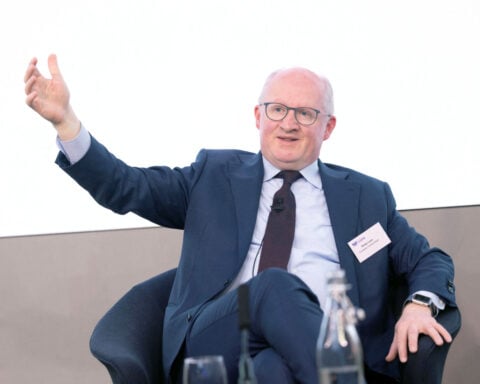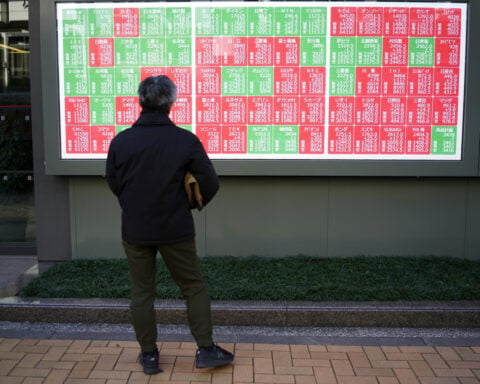By Elizabeth Howcroft and Medha Singh
LONDON (Reuters) - For Lee Rees, 43, FTX was one of a handful of exchanges on which the London-based cryptocurrency trader earned a good living, profiting off fleeting price differences across the crypto market.
When FTX collapsed last year, it took $100,000 of Rees' money, around half his annual income, with it.
"It affected my life," he said. "I had a life to pay for. It's like your boss doesn't pay you. You can't live, can you?"

Rees is one of more than an estimated 1 million customers potentially facing losses after FTX, one of the largest crypto exchanges at the time, suddenly collapsed and filed for bankruptcy in November. It soon emerged that customer funds had gone missing.
FTX founder and former-CEO Sam Bankman-Fried is accused of embezzling $10 billion from unsuspecting customers to prop up his hedge fund Alameda Research, buy luxury properties and fund political donations. His trial began in New York this week.
On Wednesday, Bankman-Fried's attorney told the court his client had overlooked risk management but did not steal customer money. Bankman-Fried has pleaded not guilty to the charges.

Prosecutors are calling some FTX customers to testify that they were told their assets were safe, and to share how FTX's collapse affected them.
Customers Reuters spoke with said they have created support groups to help each another navigate the complex bankruptcy claims process, while others said they have been targeted by scammers promising to retrieve their cash.
And some – undeterred - are back on the crypto roller coaster.
"As the crypto market has recovered, many FTX customers are concluding that they can sell their claim, buy crypto again, and do much better than letting their claim depreciate," said Matthew Sedigh, CEO of Xclaim, a bankruptcy claims exchange.
BACK IN THE MARKET
The crypto industry grew rapidly during 2020 and 2021 but in 2022 token prices plummeted as interest rates rose and investors moved their money elsewhere, sparking a string of collapses.
Currently, around $30 billion to $35 billion worth of crypto is locked up in cryptocurrency bankruptcies, with around 15 million people affected, according to Xclaim. There was about $16 billion in crypto stuck in FTX when it collapsed, according to Xclaim.
John Ray, a specialist hired to handle the bankruptcy, has described failures of financial record-keeping within FTX, and customer funds being used to buy homes and other personal items for FTX staff. This makes the bankruptcy process complicated.
Rees submitted his claim via a website created by bankruptcy administrators Kroll, a process he described as a “nightmare”.
"All these terms were so complicated. You need a lawyer to understand it.... We don't know if we're getting our money back or not."
Kroll and FTX did not respond to requests for comment sent via email. FTX has recouped $7.3 billion of the missing funds as of April, but people interviewed by Reuters said they had yet to get any money back.
"I think there is a risk that there will be many victims who will find themselves victims again because of this procedure,” said Maxime, a 32-year-old Belgian, who has also found the bankruptcy claims process difficult.
Maxime, who asked Reuters to withhold his full name, said he had a “six-figure” sum on FTX - profit from trading crypto since 2017. "This amount was above all the hope of a better life," he added.
Some creditors Reuters interviewed declined to share evidence of their FTX claims because they contained personal information. Reuters was not able to verify the size of their claims.
On Wednesday, prosecutors called Marc Antoine-Julliard, an FTX customer who had about $100,000 worth of assets with FTX. He said he had believed that Bankman-Fried had "wanted to do good." When asked how he felt when his request to withdraw funds from FTX was not processed just days before FTX filed for bankruptcy, he replied: "Extremely anxious."
'A GREAT SUPPORT'
Looking for answers, FTX creditors have created support groups. Maxime has joined several, including a Telegram group with 3000 people, he said via email. "We discuss FTX assets, procedures… it's a great support."
Sunil Kavuri, a financier who said he lost “seven-figures” on FTX, decided to start posting information about the bankruptcy on social media platform X, formerly known as Twitter, to combat misinformation.
He quickly built a following and says he now receives dozens of messages daily from creditors asking for advice.
"I thought, I have to do something." The creditors he speaks to are "really angry" and "hurt," he said. "It's really sad."
Creditors have also become targets of new scams. Maxime said he had received emails claiming he is eligible to recover his funds which take him to a phishing site. Kavuri said he has been targeted by similar schemes.
The bankruptcy process is expected to stretch into 2024 and some creditors, tired of waiting, have sold their claim. Xclaim lists over 2,000 FTX claims for sale, worth around $610 million at last November's crypto prices, Sedigh said.
Maxime, who is sticking with the bankruptcy process, said that if he gets his money back he will continue investing in crypto, but if not then he will stop. He said he will be “more wary” about which platforms he uses but “the industry will survive.”
(Additional reporting by Luc Cohen in New York; editing by Michelle Price in Washington and Sharon Singleton)

 TikTok preparing for U.S. shut-off on Sunday, The Information reports
TikTok preparing for U.S. shut-off on Sunday, The Information reports
 Japan's Makino Milling requests changes to unsolicited bid from Nidec
Japan's Makino Milling requests changes to unsolicited bid from Nidec
 South Korea's Yoon likely to be held in a solitary cell
South Korea's Yoon likely to be held in a solitary cell
 Trump's Greenland bid stirs debate in China about what to do with Taiwan
Trump's Greenland bid stirs debate in China about what to do with Taiwan
 Inflation duo takes centre stage
Inflation duo takes centre stage
 As Los Angeles burns, Hollywood's Oscar season turns into a pledge drive
As Los Angeles burns, Hollywood's Oscar season turns into a pledge drive
 As fires ravage Los Angeles, Tiger Woods isn't sure what will happen with Riviera tournament
As fires ravage Los Angeles, Tiger Woods isn't sure what will happen with Riviera tournament
 Antetokounmpo gets 50th career triple-double as Bucks win 130-115 to end Kings' 7-game win streak
Antetokounmpo gets 50th career triple-double as Bucks win 130-115 to end Kings' 7-game win streak








